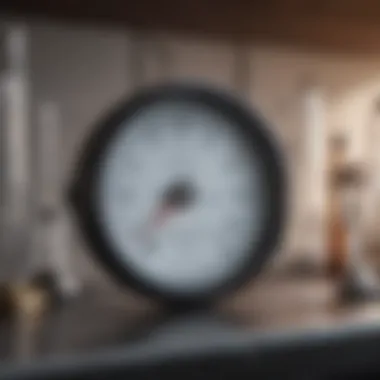Understanding Saturated Oxygen Levels and Their Impact


Intro
In the grand tapestry of life, oxygen weaves a critical thread. While often taken for granted, the levels of saturated oxygen in specific settings can significantly influence biological systems, ecological balances, and even human health. This article aims to pull back the curtain on this vital substance, exploring its myriad dimensions across various realms.
Oxygen saturation, essentially a measure of how much oxygen is being transported in the blood, has important implications in different contexts. In blue waters, it marks the dance of aquatic life; in clinical settings, it bolsters health monitoring. Understanding saturated oxygen levels isn't merely an academic exercise; it’s a lifeline, a gauge that tells us about the state of our ecosystems and communities.
As we embark on this exploration, keep in mind that oxygen saturation isn’t static. Fluctuations can arise from various factors, including environmental changes, altitude variations, and human activities. Therefore, we’ll navigate through established theories, historical frameworks, and cutting-edge research that collectively elucidate the profound implications of this concept.
Understanding Saturated Oxygen Levels
When delving into saturated oxygen levels, it's important to grasp their fundamental role in both living organisms and the environment. This topic encompasses a variety of interests ranging from healthcare to ecological studies. Oxygen is not just a mere component in the air we breathe; it is vital for survival, energy production, and biochemical reactions within the body. Understanding how oxygen saturation impacts life is essential for educators, researchers, and professionals alike.
This exploration will touch upon several key factors:
- Definition: What exactly are saturated oxygen levels?
- Historical Context: How has understanding evolved over time?
- Biological Relevance: Why is oxygen saturation crucial for living systems?
By addressing these elements, we create a robust framework that illuminates the significance of oxygen levels in various contexts, whether it be human physiology, aquatic environments, or medical applications.
Definition of Saturated Oxygen Levels
Saturated oxygen levels refer to the maximum percentage of oxygen that can dissolve in a liquid at a given temperature and pressure. For instance, in human blood, oxygen saturation specifically indicates the proportion of hemoglobin binding sites in the bloodstream occupied by oxygen. This saturation level can range from 0% to 100%, where 100% indicates full oxygen binding capacity. A healthy individual typically maintains saturation levels above 95% under normal atmospheric conditions. Understanding this threshold is crucial because deviations can signal various health issues or physiological challenges.
Historical Evolution of the Concept
The concept of saturated oxygen levels hasn't always been clear-cut. Historically, the understanding began with basic observations of respiration and evolved into structured scientific inquiry. In the 19th century, scientists like John Dalton and Amedeo Avogadro set the stage by elucidating gas laws that pertain to oxygen behavior and its interaction with other gases. Later on, advancements in technology allowed for more precise measurements, gradually leading to modern methods like pulse oximetry that assess saturation non-invasively.
"Historical inquiries into oxygen saturation remind us that science is a tapestry woven from countless discoveries and insights."
The journey from the early curiosity of natural philosophers to the intricate understanding of gas exchanges marks a significant evolution in physiology and medicine.
Importance of Oxygen Saturation in Living Systems
Oxygen saturation holds immense significance across various living systems. Here are some points to consider:
- Energy Production: Oxygen plays a central role in cellular respiration, a process that converts food into usable energy. Understanding oxygen levels is critical in fields such as gerontology and sports science.
- Disease Indicators: Low oxygen saturation can point to respiratory or cardiovascular problems. For health professionals, monitoring these levels becomes essential for diagnosing conditions, managing patient care, and predicting potential complications.
- Ecological Balance: In marine environments, oxygen levels in water directly influence biodiversity. Aquatic organisms, such as fish and invertebrates, rely on specific oxygen concentrations to thrive. Fluctuations can lead to ecological imbalances, potentially endangering species and disrupting ecosystems.
Recognizing these elements underpins why the study of saturated oxygen levels is not merely an academic pursuit; it's a vital consideration that affects health, environments, and sustainability.
Physiological Mechanisms
The body’s ability to manage oxygen levels is a cornerstone in understanding how living organisms function. Oxygen does not just float around aimlessly; it actually plays a critical role in the myriad processes that keep us alive. In the context of saturated oxygen levels, the mechanisms through which oxygen is transported, utilized, and regulated are pivotal. These physiological mechanisms are not only significant for academic discourse but also have practical implications in healthcare and environmental studies. They help explain how varying oxygen levels can affect both human health and fundamental biological processes.
Oxygen Transport in the Human Body
One key area within this topic is how oxygen is transported through the circulatory system. Oxygen enters the body primarily through the lungs when we breathe in. Once inside, it binds to hemoglobin, the iron-containing protein within red blood cells. This interaction isn’t just a passive deal; it’s rather a quintessential partnership.
- From Lungs to Cells: The oxygen from the alveoli in the lungs diffuses into the blood and attaches to hemoglobin molecules. This process is driven by differences in partial pressure, allowing oxygen to travel through the bloodstream to various tissues.
- Rate of Delivery: The saturation of hemoglobin with oxygen is crucial for delivering enough oxygen efficiently to cells. At sea level, hemoglobin can carry nearly 98% of potential oxygen saturation, ensuring that organs receive the necessary oxygen for their metabolic activities.
The ability to transport oxygen effectively can be affected by various factors, including physical fitness, lung health, and whether a person has underlying health conditions. When we think about it, this transport mechanism is akin to a delivery service ensuring that, day in and day out, oxygen is reaching its intended targets on time.
Role of Hemoglobin in Oxygen Saturation
Hemoglobin is often hailed as the hero of oxygen transport. This protein is highly specialized, exhibiting unique properties that ensure efficient oxygen binding and release. Its function goes beyond merely carrying oxygen; it also plays a part in regulating blood pH and enabling carbon dioxide transport back to the lungs for expiration.
- Oxygen Affinity: Hemoglobin’s affinity for oxygen is not static; it varies in response to several conditions, such as pH, temperature, and the concentration of carbon dioxide. This adaptability means that, in active tissues, where higher carbon dioxide levels indicate increased metabolic activity, hemoglobin releases more oxygen. It’s almost as if hemoglobin can read the room and adjust its behavior accordingly.
- Oxygen Saturation Levels: Measuring hemoglobin’s saturation can provide insights into how efficiently oxygen is being delivered throughout the body. A high level of saturation reflects good lung function, whereas low saturation levels might indicate respiratory issues or other health complications.
Impact of Altitude on Oxygen Levels
Altitude introduces another layer of complexity to the discussion of oxygen levels. As one ascends to higher altitudes, the atmospheric pressure drops, which leads to decreased availability of oxygen. This phenomenon can have profound effects on both human physiology and performance.


- Acclimatization: When one moves to higher elevations, the body begins to acclimatize. Increased breathing rates, heightened heart rates, and an increase in red blood cell production are among the adjustments made. This process helps enhance oxygen transport despite the lower saturation level in the environment.
- Hypoxia: On the flip side, if the body cannot accommodate the change, individuals may experience hypoxia, a state in which the body or a region of the body is deprived of adequate oxygen supply. Symptoms can range from mild fatigue to severe issues like altitude sickness.
In summary, understanding the physiological mechanisms behind oxygen transport and saturation helps elucidate broader biological processes. Oxygen levels, both high and low, can significantly impact health, physiological functioning, and even athletic performance. Its transport dynamics, the indispensable role of hemoglobin, and the influence of external factors like altitude create a fascinating narrative of adaptation and survival.
Measurement Techniques
Measurement techniques for oxygen saturation are crucial in various fields, from medical practices to environmental monitoring. Accurately gauging oxygen levels is essential for understanding both health and ecological dynamics. Different methods exist, each with unique advantages and considerations. A robust measurement can inform treatment plans in healthcare, providing insights into how oxygen levels affect patient outcomes, and it can also determine water quality and ecosystem health in environmental settings.
Methods to Measure Oxygen Saturation
Several techniques are employed to measure oxygen saturation in both clinical and environmental contexts. Each method comes with its strengths and weaknesses, which determines their application.
- Invasive Methods: Arterial blood gas (ABG) sampling is arguably the gold standard. By collecting blood directly from an artery, professionals can achieve precise saturation readings. While this method is accurate, it carries risks, such as infection or discomfort, making it less favorable for routine checks.
- Non-Invasive Methods: Devices like pulse oximeters have revolutionized the measurement landscape. These handy gadgets use light wavelengths to assess the blood's oxygen saturation by shining two different light beams through a fingertip or earlobe. They offer quick readings and can be used easily in various settings, from hospitals to home care. However, factors such as nail polish and ambient light can interfere with accuracy.
"Reliable oxygen measurement is not just a routine check but a cornerstone of effective patient management and ecological assessment."
Understanding Pulse Oximetry
Pulse oximetry is one of the most popular non-invasive techniques for monitoring oxygen saturation. The device provides a real-time reading and is often found in emergency rooms, operating rooms, and even homes. It detects changes in the color of blood, which indicates oxygen levels. While pulse oximeters are user-friendly, understanding their limitations is equally vital.
- Advantages:
- Disadvantages:
- Quick and easy to use
- Immediate feedback on oxygen saturation
- Portable for at-home use
- Accuracy may drop if peripheral blood flow is compromised, such as in shock or severe cold.
- Can be affected by motion artefacts.
While these devices are generally reliable, healthcare providers should interpret their readings with caution, particularly in clinical decision-making.
Advanced Techniques and Technologies
As technology evolves, so do the methods for measuring oxygen saturation. Advanced techniques have emerged that promise greater accuracy and functionality.
- Transcutaneous Monitoring: This method measures oxygen and carbon dioxide levels through the skin. While less common, it's valuable in neonatology, allowing continuous monitoring without blood draws.
- Near-Infrared Spectroscopy (NIRS): This technique permits non-invasive monitoring of hemoglobin saturation in tissues. It shows considerable promise in research and specific clinical applications, providing insights into oxygen delivery at the cellular level.
The continuous advancement in technologies enhances our understanding of oxygen dynamics, enabling researchers and clinicians to make informed decisions based on precise measures of oxygen saturation. As the field grows, further exploration will help optimize both clinical and environmental applications.
Health Implications
The realm of health implications tied to saturated oxygen levels is vast and multifaceted, threading its way through both human wellbeing and the functioning of various biological systems. Understanding how oxygen saturation influences health is not merely an academic exercise; it’s essential for effective diagnosis and treatment in clinical environments.
"Proper oxygen saturation is the cornerstone of physiological health; deviations, whether high or low, can lead to serious health risks."
Effects of Low Oxygen Saturation Levels
Low oxygen saturation, often termed hypoxemia, occurs when blood oxygen levels fall below normal thresholds. This condition can manifest through a variety of symptoms, including shortness of breath, fatigue, and confusion. Essentially, when oxygen levels dip too low, it compromises the body’s ability to perform essential functions.
Moreover, chronic hypoxemia can lead to significant health complications such as pulmonary hypertension and right heart failure. When organs and tissues don’t receive adequate oxygen, their functionality declines, leading to a state called hypoxia, where cells begin to die due to lack of energy. The implications are severe:
- Increased Workload on the Heart: The heart struggles to pump oxygen to meet the body’s demands.
- Cognitive Impairments: Oxygen is vital for brain function; low levels can contribute to cognitive decline.
- Worsening of Pre-existing Conditions: Conditions like asthma or COPD may escalate.
In clinical settings, monitoring oxygen saturation helps identify individuals at risk, permitting timely interventions that can lead to improved outcomes.
Hyperoxia: Consequences of High Saturation
On the flip side, hyperoxia — an excess of oxygen in the tissues — can also pose risks. While sufficient oxygen is critical for healing, too much can lead to toxicity, damaging lung function and other tissues. This is especially relevant in therapeutic scenarios, such as oxygen therapy, where controlled oxygen delivery is crucial.
Potential effects include:
- Oxygen Toxicity: High concentrations can lead to inflammation and damage in lung tissues.
- Central Nervous System Effects: In severe cases, symptoms may arise such as seizures or visually disturbances.
- Altered Natural Respiratory Drive: Over time, reliance on supplemental oxygen can reduce the body’s natural ability to regulate respiration.


Healthcare providers must balance the use of oxygen therapy while keeping an eye on the levels, as hyperoxia can also counteract beneficial effects that are sought in treatment.
Oxygen Therapy and Clinical Applications
Oxygen therapy has revolutionized treatment protocols for numerous conditions associated with both low and high saturation levels. This method enhances oxygen concentration in the blood, addressing issues that may arise from conditions like COPD, sleep apnea, or pneumonia.
When applied correctly, oxygen therapy can lead to:
- Increased Exercise Tolerance: Many patients report improved ability to carry out daily activities.
- Enhanced Recovery: Post-surgery patients often heal faster with optimal oxygen levels.
- Improved Quality of Life: Simply feeling better leads to significant psychological benefits.
However, it requires careful oversight. Clinicians must regularly evaluate both the patient’s condition and their overall oxygen saturation, adjusting interventions appropriately. Mismanagement can lead to complications such as those discussed in the previous sections.
Environmental Context
Understanding the environmental context of saturated oxygen levels is crucial for multiple reasons. Oxygen is not just a lifeline for humans and animals, but for countless organisms in various ecosystems, especially aquatic ones. The balance of oxygen saturation affects biodiversity, ecosystem health, and ultimately impacts human activities such as fishing and recreation.
Importance of Oxygen Saturation in Aquatic Ecosystems
Aquatic ecosystems, such as lakes, rivers, and oceans, have unique oxygen dynamics. The saturation levels of oxygen can dictate which species thrive and which struggle to survive. In water, oxygen saturation is influenced by factors such as temperature, salinity, and pressure.
- Dissolved Oxygen (DO): In aquatic environments, oxygen is vital in its dissolved form, necessary for fish and other marine life.
- Species Diversity: Higher saturation levels generally support a greater diversity of organisms. For instance, coral reefs flourish in well-oxygenated waters, while areas with low oxygen, such as dead zones, show a stark decline in species diversity.
- Nutrient Cycling: Oxygen plays a role in promoting beneficial microbial activity that decomposes organic material, maintaining ecosystem balance.
A healthy ecosystem relies heavily on optimal oxygen levels. When these levels drop, the repercussions can be dire, leading to the extinction of sensitive species and altering the food chain.
Impact of Pollution on Oxygen Levels
Pollution introduces an array of challenges that compromise oxygen saturation in aquatic environments. Nutrient pollution, primarily from agricultural runoff, leads to algal blooms, which subsequently deplete oxygen levels when they die and decompose. This process can create dead zones where aquatic life cannot survive.
- Eutrophication: Over-fertilization from crops can cause algal blooms that consume vast amounts of oxygen.
- Industrial Waste: Discharges from factories can add toxic substances, impairing oxygen transportation in water systems.
- Sewage Discharges: The introduction of untreated sewage can lead to high levels of organic matter in water, increasing the oxygen demand for decomposition.
Addressing pollution is not only essential for aquatic health but has critical implications for local economies reliant on fishing and tourism. Cleaner waterways help preserve biodiversity and ensure the sustainability of these communities.
Oxygen Depletion Events: Causes and Effects
Oxygen depletion events, often referred to as hypoxic events, have gained significance globally due to their increasing frequency. These episodes occur when dissolved oxygen levels drop significantly, often leading to large fish kills and a chaotic shift in species composition.
Causes of Oxygen Depletion:
- High Temperatures: Warmer waters can hold less oxygen, exacerbating natural seasonal depletion.
- Increased Nutrients: As previously mentioned, runoff laden with nitrogen and phosphorus stimulates excessive plant growth followed by decomposition.
- Water Stratification: In some environments, due to temperature or salinity, water layers can separate, preventing oxygen from mixing into deeper layers.
Effects of Oxygen Depletion:
- Biodiversity Loss: Many species may migrate away from low oxygen areas, causing ecosystem imbalances.
- Fisheries Impact: Lower fish populations directly affect local fishery economies, leading to decline in livelihoods.
- Human Health Risks: Decomposing matter can release harmful substances, leading to health advisories for water usage.
Overall, grasping the environmental implications of saturated oxygen levels is vital not only for ecological knowledge but also for informing policy decisions that protect these essential systems. By keeping a close watch on oxygen saturation and addressing associated challenges, we can ensure healthier ecosystems for future generations.
Technological Advances
Technological advances in monitoring oxygen levels are nothing short of revolutionary. These innovations play a critical role in myriad fields, from healthcare to environmental science. They enable us to gather data that is not only precise but also timely. Enhanced monitoring systems are essential as they empower researchers and healthcare professionals to adapt quickly to changing oxygen saturation levels, whether in patients or in aquatic ecosystems.
Innovations in Oxygen Monitoring Devices
In recent years, notable advancements have been made in the realm of oxygen monitoring devices. For instance, portable pulse oximeters have become increasingly accessible, enabling both healthcare providers and patients to track oxygen saturation levels conveniently. These compact devices allow for real-time data acquisition, which is pivotal for identifying anomalies in oxygen levels in various settings.
Some newer models utilize advanced sensors that provide accurate readings even in challenging conditions, such as motion artifacts or low perfusion states. Just consider the Masimo RAD-57, which employs innovative technology to assess not just oxygen saturation but also carboxyhemoglobin levels. This multifaceted approach offers a more comprehensive insight into an individual’s respiratory status.
Additionally, wearable technologies are beginning to infiltrate the market, with devices that continuously monitor oxygen levels during various activities. This development could dramatically improve our understanding of how physical exertion affects oxygen saturation in real-time, offering insights that are particularly relevant for athletes or those with respiratory conditions.
Applications in Healthcare and Research


The implications of these monitoring advancements reach far beyond convenience. In the healthcare sector, timely and accurate readings can be lifesaving. For patients with chronic obstructive pulmonary disease, asthma, or other respiratory issues, having immediate access to oxygen saturation data allows for prompt interventions. For example, if a patient's levels drop unexpectedly, healthcare teams can respond quicker, adjusting oxygen therapy or treatments much sooner than before.
In research, these devices are paving the way for more nuanced studies into the effects of varying oxygen levels on different demographics. Researchers can now conduct studies under controlled conditions that were not feasible in the past. Consider the data gathered in extreme environments, such as high-altitude physiology studies. With precise monitoring, scientists can understand how these environments affect human performance and health, thus broadening our knowledge base.
Future Directions in Oxygen Level Regulation
Looking ahead, the future of oxygen level regulation seems promising, driven by ongoing technological innovations. There is potential for the integration of artificial intelligence and machine learning in predictive models for oxygen saturation. Such systems could analyze vast amounts of data, identifying patterns and risk factors, and ultimately enhancing patient outcomes.
Moreover, the development of more sophisticated algorithms could improve wearable technologies, enabling them to predict fluctuations in oxygen levels based on activity and health conditions. This might provide a leap towards personalized medicine, where treatment protocols are tailored not just to individual patients but to their unique patterns in real-time.
Additionally, environmental monitoring systems are expected to evolve, providing a more comprehensive picture of how oxygen saturation levels fluctuate within ecosystems. This can lead to better conservation strategies for vulnerable species or habitats affected by pollution and climate change.
"The ability to accurately monitor and respond to oxygen saturation levels can change the game for both healthcare and ecological preservation."
In summary, the innovations in technological devices for monitoring oxygen saturation stand at the forefront of both health and environmental research. They not only enhance our understanding of oxygen dynamics but also offer life-saving capabilities that were once merely aspirational.
Relevant Case Studies
The examination of saturated oxygen levels does not solely hinge on theoretical concepts and scientific principles; practical case studies provide vital illustrations of how these principles manifest in real life. By examining different instances where oxygen saturation plays a pivotal role in both ecological and clinical contexts, we can gain insights that abstract data alone might not convey. The value of relevant case studies lies in their ability to bridge the gap between theory and practice, allowing us to assess the implications of oxygen levels in diverse environments.
Human Response to Environmental Changes in Oxygen Levels
The human body's ability to respond to changing oxygen levels can be quite remarkable. For instance, individuals living at higher altitudes, like the Andes or Himalayas, often display physiological adaptations to cope with lower oxygen saturation in the atmosphere. A study on populations in Bolivia revealed that these high-altitude dwellers possess larger lung capacities and increased red blood cell counts. This adaptation allows them to maintain a functional oxygen saturation level, despite the reduced availability of oxygen.
Similarly, during instances of acute environmental disruption, such as wildfires or urban pollution, acute oxygen deprivation can trigger significant health reactions. It’s not uncommon for individuals exposed to such conditions to experience symptoms ranging from breathlessness to more serious respiratory complications. The human body has an impressive ability to acclimatize, but prolonged exposure to lowered oxygen levels can lead to serious health consequences, including conditions like Chronic Obstructive Pulmonary Disease (COPD).
"The human body, though resilient, has its limitations. The balance of oxygen intake is crucial for sustaining life and health."
Aquatic Life Adaptations to Varying Saturation Levels
In the underwater world, oxygen saturation directly impacts life. For instance, fish species in environments with fluctuating oxygen levels develop unique adaptations. Take the Carp and Catfish for example; these species are known to thrive in low-oxygen waters by employing various physiological strategies.
Carp are capable of tolerating low oxygen through a process called anaerobic respiration, allowing them to survive when other species might flounder. Likewise, certain Catfish possess specialized structures that enable them to gulp air directly from the surface. This adaptation is invaluable in stagnant waters where oxygen depletion is often an issue. Many estuarine and freshwater ecosystems are on the edge of oxygen saturation; understanding how these organisms navigate their environments can shed light on broader ecological impacts.
Clinical Case Studies: Oxygen Therapy Outcomes
Clinical applications of oxygen therapy illustrate the importance of maintaining optimal oxygen saturation levels in medical settings. One notable case involved patients with severe COVID-19 pneumonia requiring oxygen supplementation. Research outlined varying responses to High-Flow Nasal Cannula therapy, which was implemented to enhance oxygenation.
In a controlled study, it was found that patients receiving this type of therapy exhibited marked improvements in oxygen saturation compared to those given traditional methods. As a result, oxygen therapy emerged as a focal point of intervention, spotlighting how proper saturation techniques are critical in managing acute health crises.
Moreover, analyzing the outcomes of Hyperbaric Oxygen Therapy in treating wounds also reveals profound insights into the medical applications of oxygen saturation. Clinical trials demonstrate how increased levels of oxygen under pressure can promote healing and reduce infection rates in chronic wounds. Such findings emphasize the need for continued research in oxygen therapies, ultimately advancing our understanding of how to best utilize oxygen in medical practice.
Future Research and Developments
Exploring the future of oxygen saturation research opens a Pandora's box of possibilities. This discussion is not merely academic; it has tangible benefits that ripple across healthcare, environmental science, and beyond. Understanding these developments is crucial as they may shape how we address the evolving challenges surrounding oxygen levels in various contexts.
Emerging Trends in Oxygen Saturation Research
Researchers are venturing into uncharted waters when it comes to oxygen saturation levels. A notable trend is the development of more precise monitoring tools. Traditional methods rely heavily on pulse oximetry, which, while effective, can sometimes provide misleading readings. Innovation is key. New technologies, such as advanced imaging techniques and wearable sensors, are shaping a more accurate landscape. These devices monitor not just oxygen saturation but also other vital parameters, painting a more comprehensive picture of a subject's health.
Moreover, there's a growing interest in how oxygen levels fluctuate with different lifestyles. Studies are diving deep into how activities like high-intensity training or meditation influence oxygen saturation. The findings could lead to personalized health interventions that aren't one-size-fits-all but rather tailored to individual needs.
Interdisciplinary Approaches to Oxygen Studies
In today's complex world, addressing oxygen saturation levels requires an interdisciplinary lens. We've hit a point where biology, environmental science, and technology intersect. For instance, collaborations between biologists and engineers are crucial for developing new monitoring tools that can operate in diverse environments, be it deep-sea explorations or high-altitude research sites.
Engaging anthropologists and sociologists also sheds light on how human behavior impacts oxygen levels. By understanding cultural practices and socioeconomic factors, researchers can identify communities at risk due to poor oxygen conditions. This holistic approach fosters comprehensive strategies to mitigate those risks, connecting science with real-world application.
Potential Impact on Global Health and Ecology
Diving into the potential impacts of oxygen level research highlights pressing global issues. For one, oxygen saturation affects not just individual health but also public health systems. With a significant percentage of the world's population suffering from respiratory issues, understanding oxygen levels can inform healthcare policies and interventions. Better data on oxygen saturation can lead to improved management of conditions like COPD or asthma, ultimately saving lives.
Furthermore, oxygen levels do not exist in a vacuum; they are intimately tied to our ecology. Aquatic ecosystems are particularly sensitive to changes in oxygen saturation due to pollution or climate change. Researching these effects helps inform conservation efforts and policy-making.
"Knowledge of oxygen levels is not just a scientific concern; it shapes the lives of billions and the health of our planet."







